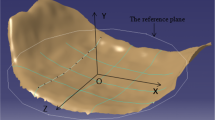Abstract
Full-scale three-dimensional (3D) models offer a useful tool in preoperative planning, allowing full-scale stereoscopic recognition from any direction and distance with tactile feedback. Although skills and implants have progressed with various innovations, rheumatoid cervical spine surgery remains challenging. No previous studies have documented the usefulness of full-scale 3D models in this complicated situation. The present study assessed the utility of full-scale 3D models in rheumatoid cervical spine surgery. Polyurethane or plaster 3D models of 15 full-sized occipitocervical or upper cervical spines were fabricated using rapid prototyping (stereolithography) techniques from 1-mm slices of individual CT data. A comfortable alignment for patients was reproduced from CT data obtained with the patient in a comfortable occipitocervical position. Usefulness of these models was analyzed. Using models as a template, appropriate shape of the plate-rod construct could be created in advance. No troublesome Halo-vests were needed for preoperative adjustment of occipitocervical angle. No patients complained of dysphasia following surgery. Screw entry points and trajectories were simultaneously determined with full-scale dimensions and perspective, proving particularly valuable in cases involving high-riding vertebral artery. Full-scale stereoscopic recognition has never been achieved with any existing imaging modalities. Full-scale 3D models thus appear useful and applicable to all complicated spinal surgeries. The combination of computer-assisted navigation systems and full-scale 3D models appears likely to provide much better surgical results.




Similar content being viewed by others
References
Abumi K, Takada K, Shono Y, Kaneda K, Fujiya M (1999) Posterior occipitocervical reconstruction using cervical pedicle screws and plate-rod systems. Spine 24:1425–1434
Abumi K, Kaneda K, Shono Y, Fujiya M (1999) One-stage posterior decompression and reconstruction of the cervical spine by using pedicle screw fixation systems. J Neurosurg 90:19–26
Brown GA, Milner B, Firoozbakhsh K (2002) Application of computer-generated stereolithography and interpositioning template in acetabular fractures: a report of eight cases. J Orthop Trauma 16:347–352
Brown GA, Firoozbakhsh K, DeCoster TA, Reyna JR, Moneim M (2003) Rapid prototyping: the future of trauma surgery? J Bone Joint Surg Am 85A(Suppl 4):49–55
Chen JF, Wu CT, Lee SC, Lee ST (2005) Posterior atlantoaxial transpedicular screw and plate fixation. J Neurosurg Spine 2:386–392
van Dick M, Smit TH, Jiya TU, Wuisman PI (2001) Polyurethane real-size models used in planning complex spinal surgery. Spine 26:1920–1926
D’Urso PS, Askin G, Earwaker JS, Merry GS, Thompson RG, Baker TM et.al (1999) Spinal biomodeling. Spine 24:1247–1251
Ebraheim NA, Lu J, Biyani A, Brown JA, Yeasting RA (1996) An anatomic study of the thickness of the occipital bone. Implications for occipitocervical instrumentation. Spine 21:1725–1729
Harms J, Melcher RP (2001) Posterior C1–C2 fusion with polyaxial screw, rod fixation. Spine 26:2467–2471
Magerl F, Seemann PS, Gallen S (1987) Stable posterior fusion of the atlas and axis by transarticular screw fixation. In: Kehr P, Weidner A (eds) Cervical spine 1. Springer, New York, pp 322–327
Matsubara T, Mizutani J, Fukuoka M, Hatoh T, Kojima H, Otsuka T (2007) Safe atlantoaxial fixation using a laminar screw (intralaminar screw) in a patient with unilateral occlusion of vertebral artery. Spine 32:E30–E33
Morishita N, Ohota K, Miura Y (2005) The influences of Halo-Vest fixation and cervical hyperextension on swallowing in healthy volunteers. Spine 30:E179–E182
Garfin SR, Botte MJ, Waters RL (1986) Complication in the use of the halo fixation device. J Bone Joint Surg 68-A:320–325
Mizutani J, Tsubouchi S, Fukuoka M, Otsuka T, Matsui N (2002) Surgical treatment of the rheumatoid cervical spine in patients aged 70 years or older. Rheumatology 41:910–916
Mizutani J, Tsubouchi S, Fukuoka M, Otsuka T, Matsui N (2002) Syringomyelia caused by loosening of multistrand cables following C1–2 Brooks-type fusion in the rheumatoid cervical spine. J Neurosurg 97(Suppl 3):366–368
Nadim Y, Lu J, Sabry FF, Ebraheim N (2000) Occipital screws in occipitocervical fusion, their relation to the venous sinuses: an anatomic and radiographic study. Orthopedics 23:717–719
Nicholas JM, Andrew MC, Noel GS (1990) The display of three-dimensional anatomy with stereolithographic models. J Digit Imaging 3:200–203
Onishi K, Maruyama Y (2001) Three-dimensional solid model integrated with dental model for maxillofacial surgery. Plast Reconstr Surg 108:1696–1699
Ono I, Abe K, Shiotani S, Hirayama K (2000) Producing a full-scale model from computed tomographic data with the rapid prototyping technique using the binder jet method: a comparison with the laser lithography method using a dry skull. J Craniofac Surg 11:527–537
Seichi A, Takeshita K, Nakajima S, Akune T, Kawaguchi H, Nakamura K (2005) Revision cervical spine surgery using transarticular or pedicle screws under a computer-assisted image-guidance system. J Orthop Sci 10:385–390
Stoker NG, Mankovich NJ, Valentino D (1992) Stereolithographic models for surgical planning: preliminary report. J Oral Maxillofac Surg 50:466–471
Tan M, Wang H, Wang Y, Zhang G, Yi P, Li Z et al (2003) Morphometric evaluation of screw fixation in atlas via posterior arch and lateral mass. Spine 28:888–895
Wagner JD, Baack B, Brown GA, Kelly J (2004) Rapid 3-dimensional prototyping for surgical repair of maxillofacial fractures: a technical note. J Oral Maxillofac Surg 62:898–901
Winder J, Bibb R (2005) Medical rapid prototyping technologies: state of the art and current limitations for application in oral and maxillofacial surgery. J Oral Maxillofac Surg 63:1006–1015
Acknowledgments
We wish to thank Ms.Yoko Sugiyama and Yoko Hirose for secretarial assistance. This study was supported by a Grant-in-Aid for Scientific Research (C: No. 19591728) from the Ministry of Education, Culture, Sports, Science and Technology of Japan, and a Grant-in-Aid for Research from Nagoya City University (EX-3-L, No. 1).
Author information
Authors and Affiliations
Corresponding author
Rights and permissions
About this article
Cite this article
Mizutani, J., Matsubara, T., Fukuoka, M. et al. Application of full-scale three-dimensional models in patients with rheumatoid cervical spine. Eur Spine J 17, 644–649 (2008). https://doi.org/10.1007/s00586-008-0611-3
Received:
Revised:
Accepted:
Published:
Issue Date:
DOI: https://doi.org/10.1007/s00586-008-0611-3




